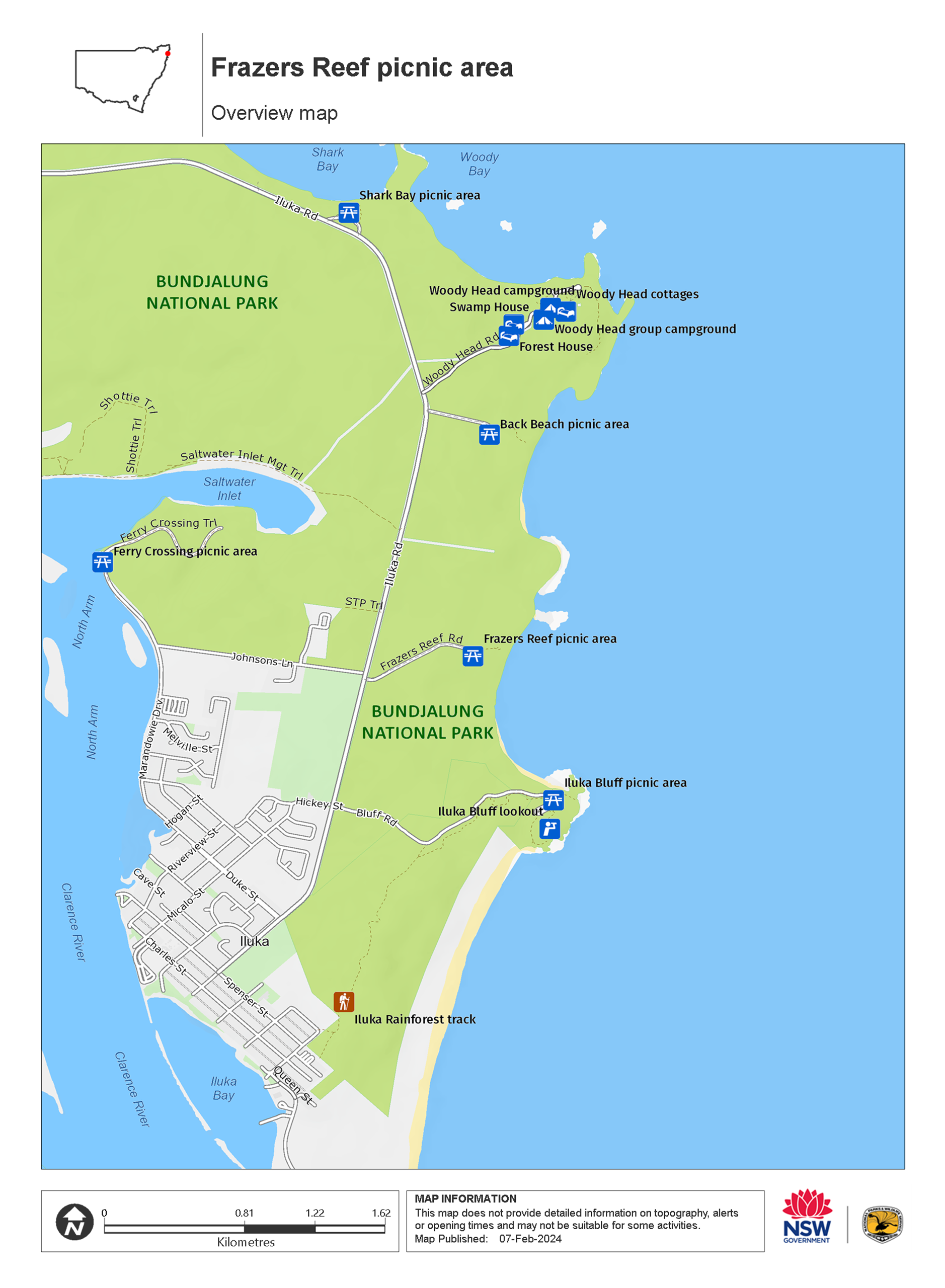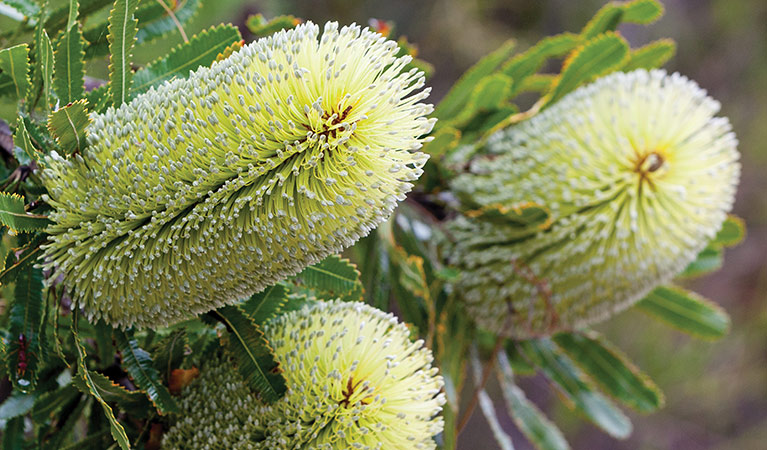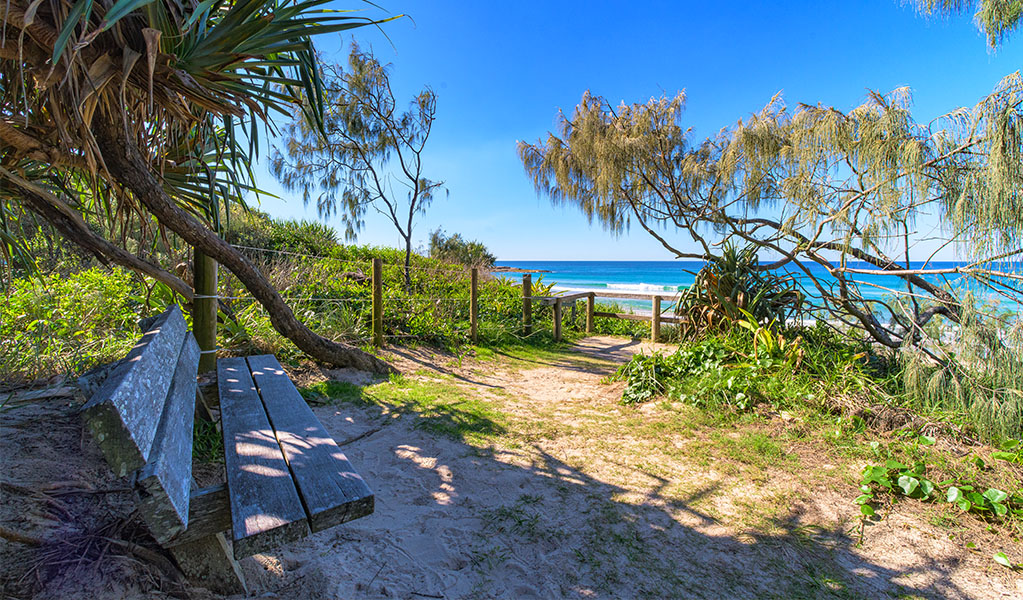Overview
Frazers Reef picnic area is in Bundjalung National Park, near Iluka Bluff lookout. Escape to this beautiful oceanside location for a picnic or enjoy a surfing, wind surfing and kitesurfing session.
Frazers Reef picnic area makes it easy to enjoy this pristine North Coast surf location. Park then set up at one of the 2 picnic tables, or spread out the grassy area for a tasty feast. With toilets nearby, it's easy for the whole family to linger and relax.
When you're ready to hit Bluff Beach, it's just a 150m stroll across flat ground. Venture out in the morning for a surf. Head out later in the day when the summer seabreeze kicks in to enjoy some kitesurfing or wind surfing. Or simply watch all the action from a peaceful lookout seat on the dunes above the beach.
Nearby
-

Iluka Bluff lookout
Stay as long as you like to enjoy the views at Iluka Bluff lookout, near Yamba. Not only is it an excellent whale watching spot, it’s also a great place to picnic.
-

Iluka Rainforest walking track
Iluka Rainforest walking track takes you on an easy stroll through lush rainforest. Unpack a picnic when you arrive at Iluka Bluff in Bundjalung National Park and enjoy stunning views and a swim.
These maps give a basic overview of park attractions and facilities, and may not be detailed enough for some activities. We recommend that you buy a topographic map before you go exploring.
Map

Map legend

Local alerts
For the latest updates on fires, closures and other alerts in this area, see https://www.nationalparks.nsw.gov.au/things-to-do/picnic-areas/frazers-reef-picnic-area/local-alerts
General enquiries
- National Parks Contact Centre
- 7am to 7pm daily
- 1300 072 757 (13000 PARKS) for the cost of a local call within Australia excluding mobiles
- parks.info@environment.nsw.gov.au
Park info
- in Bundjalung National Park in the North Coast region
Bundjalung National Park is always open but may have to close at times due to poor weather or fire danger.
-
Park entry fees:
$8 per vehicle per day.
Buy annual pass.
Visitor info
All the practical information you need to know about the Frazers Reef picnic area.
Maps and downloads
Learn more
Frazers Reef picnic area is in Bundjalung National Park. Here are just some of the reasons why this park is special:
An ancient landscape

At Bundjalung National Park you can visit Gummigurrah, an area that was used as a winter camping ground by the Bandjalung People. This park is one of a group where the Bandjalang People's native title rights have been recognised and is only the third determination of native title rights in New South Wales. Native title rights come from the Bandjalang People's traditional laws and customs and legally recognise the Bandjalang People's connection to Country. This means that these lands will continue to be places of ceremony, learning and inspiration for generations to come.
Meet the locals

The varied habitat of Bundjalung National Park is home to over 140 species of fauna. Wake to the morning melodies of eastern whip-birds, bower birds and the rare barred cuckoo-shrike. At dawn and dusk, you might find eastern grey kangaroos, red-necked wallabies and swamp wallabies congregating around your campsites. Scour the tops of nearby trees and you might also catch a glimpse of a sleeping koala or two.
- Iluka Bluff lookout Stay as long as you like to enjoy the views at Iluka Bluff lookout, near Yamba. Not only is it an excellent whale watching spot, it’s also a great place to picnic.
- Jerusalem Creek walk Keep your eyes peeled for birds nesting along the creek along the Jerusalem Creek walk. Enjoy the hike as a day walk or shorter walk and finish up with a picnic lunch.
Water world

Bundjalung protects a variety of environments that feature water, including beaches, rivers, wetlands and lagoons. You'll find different types of plants, animals and birds in each one; look for coast banksia, coast she-oak and coastal wattle on the dunes that back onto the beach. Immerse yourself in this world by canoeing the waterways, rambling in the rock pools and swimming in the ocean.
Plants and animals protected in this park
Animals
-

White-bellied sea eagle (Haliaeetus leucogaster)
White-bellied sea eagles can be easily identified by their white tail and dark grey wings. These raptors are often spotted cruising the coastal breezes throughout Australia, and make for some scenic bird watching. Powerful Australian birds of prey, they are known to mate for life, and return each year to the same nest to breed.
-

Eastern ground parrot (Pezoporus wallicus wallicus)
The eastern ground parrot is a beautiful, ground-dwelling native bird that lives in low heathland habitat along the NSW North and South coasts and escarpments. It’s listed as a vulnerable species in NSW.
-

Peron's tree frog (Litoria peroni)
Peron’s tree frog is found right across NSW. These tree-climbing and ground-dwelling Australian animals can quickly change colour, ranging from pale green-grey by day, to a reddish brown with emerald green flecks at night. The male frog has a drill-like call, which has been described as a 'maniacal cackle’.
-

Emu (Dromaius novaehollandiae)
The largest of Australian birds, the emu stands up to 2m high and is the second largest bird in the world, after the ostrich. Emus live in pairs or family groups. The male emu incubates and rears the young, which will stay with the adult emus for up to 2 years.
-

Koala (Phascolarctos cinereus)
One of the most renowned Australian animals, the tree-dwelling marsupial koala can be found in gum tree forests and woodlands across eastern NSW, Victoria and Queensland, as well as in isolated regions in South Australia. With a vice-like grip, this perhaps most iconic but endangered Australian animal lives in tall eucalypts within a home range of several hectares.
-

Lace monitor (Varanus varius)
One of Australia’s largest lizards, the carnivorous tree-dwelling lace monitor, or tree goanna, can grow to 2m in length and is found in forests and coastal tablelands across eastern Australia. These Australian animals are typically dark blue in colour with whitish spots or blotches.
-

Grey-headed flying-fox (Pteropus poliocephalus)
The grey-headed flying fox is Australia's largest native bat, with a wingspan up to 1m. This threatened species travels up and down south-eastern Australia and plays a vital role in pollinating plants and spreading seeds in our native forests.
-

Australian pelican (Pelecanus conspicillatus)
The curious pelican is Australia’s largest flying bird and has the longest bill of any bird in the world. These Australian birds are found throughout Australian waterways and the pelican uses its throat pouch to trawl for fish. Pelicans breed all year round, congregating in large colonies on secluded beaches and islands.

